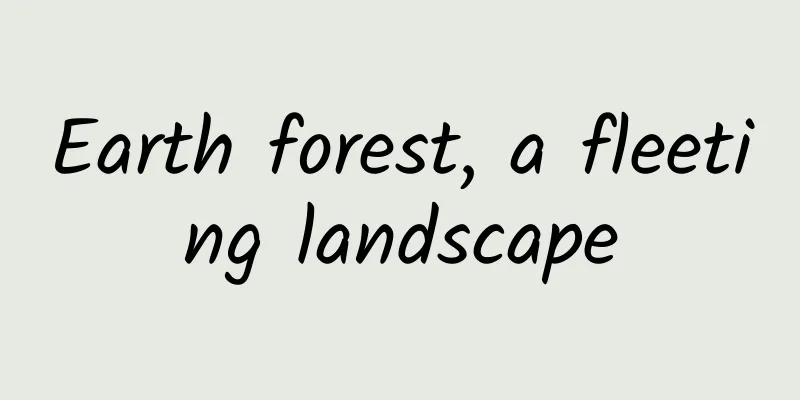Earth forest, a fleeting landscape

|
Earth forest is a kind of semi-loose and semi-consolidated sediment. Under the action of flowing water erosion, it forms a series of landforms such as forest columns, walls and valleys distributed in groups. The earth forest and the stone forest are very similar in appearance, but they are actually two completely different types of landforms. There are two most significant differences between them. One is that the materials that form the landscape are different. The material that forms the earth forest is a semi-cemented, low-lithogenic gravel layer, while the rock that forms the stone forest is generally composed of relatively dense soluble rocks such as limestone and dolomite. Therefore, the earth forest is more unstable and fragile than the stone forest, and is more easily eroded. The second is that the external dynamic conditions that form the landscape are different. The erosion that forms the earth forest is mainly caused by the leaching and scouring of seasonal running water, while the erosion of the stone forest is mainly caused by the dissolution of running water. Stone forests are more common in karst areas, while earth forests are rarely found in China. Earth forests are generally developed in small basins or valley edges of river-lake deposits, with Yuanmou in Yunnan and Zhada in Tibet being the most typical. In addition, they are also found in Jiangchuan and Nanjian in Yunnan, Xichang in Sichuan, Tianshui in Gansu, and Datong in Shanxi. Earth forests reflect paleogeographic changes and landform development processes, and often become the key to unlocking paleogeography and paleoclimate. ▲Datong Earth Forest. Photo by Li Zhongdong Formation of Earth Forest The reason why earth forests are rare is that the conditions for their formation are extremely difficult. The formation of earth forests requires at least four conditions: First, there must be a material basis suitable for the formation of soil forests, that is, there must be semi-loose and semi-consolidated debris sediments. If the sediments are too loose, they are easy to collapse and damage, and difficult to form. If they are too consolidated and dense, they are not conducive to the cutting, scouring and shaping of flowing water. Second, it must be at the edge of a basin or valley, that is, there must be a certain height difference to provide potential energy for water erosion; Third, the gravel layer that forms the soil forest generally has a layer of iron weathering crust or iron cemented gravel layer, so as to give the soil forest a "steel helmet" to prevent the soil forest from collapsing, becoming shorter, or even disappearing too quickly in wind and rain, and to maximize the possibility that the soil forest can stand for a long time. Fourth, the environment in which earth forests are formed is often arid or semi-arid areas with dry climate and little rainfall, because an overly warm climate and too abundant rainfall may cause the earth forest to disappear due to biological weathering and water erosion before it takes shape. ▲Yuanmou Earth Forest. Photo by Xie Baoxian Yuanmou Earth Forest Yuanmou Earth Forest is the place where the earth forest landform was first discovered and named. In the 1960s, when Qian Fang and other geologists from the Chinese Academy of Geological Sciences were conducting geological and geomorphological research in the Yuanmou Basin, they discovered that there were large areas of soil pillars distributed in the basin. They then named this landform "soil forest." Yuanmou soil forests are mainly distributed on the west side of Longchuan River, a tributary of Jinsha River, and along the valleys and gullies of branch streams. Among them, the larger and more typical soil forest communities include Banguo, Hutiaotan (Zhima), Wanbao, Xiaoleizai, Xinhua, etc. The area of these communities is about 5 square kilometers. ▲Yuanmou Earth Forest. Photo by Zhang Junce The parent material that formed the Yuanmou Earth Forest is mainly river and lake sediments formed 3-1.5 million years ago, with a thickness of about 600 meters. Yuanmou Man fossils and cultural relics dating back 1.7 million years ago were also found in this rock layer. A large number of mammal fossils, such as saber-toothed elephants and Chinese rhinoceros, were also unearthed. The Yuanmou Basin, where the earth forest is developed, is located in the middle section of the north-south tectonic belt of Sichuan and Yunnan. This tectonic belt has created a series of fault basins, such as Hanyuan, Xichang, Huili, Yanyuan, Hongge, Yuanmou, Kunming, Mouding, Yuxi, etc. Yuanmou Basin is one of them. The extremely thick sediments in the basin have increased the ground gradient due to tectonic uplift. As the Jinsha River cuts down strongly, the flowing water also accelerates the erosion and cutting of the Yuanmou Basin. The water often flows along loose sand layers, joints or broken zones, thus forming criss-crossing gullies and earth pillars, which eventually develop into earth forests. Three weathering crusts have also developed in the Yuanmou Basin. The weathering crusts developed in the earth forest area are mainly hard red iron weathering crusts, which are 0.5-1 meters thick. They act like umbrellas to keep the soil columns from being destroyed or collapsed by water for a long time. ▲Yuanmou Earth Forest. Photo by Zhang Junce Huanglian soil forest Huanglian Earth Forest is located in Huanglianguan Town, 30 kilometers south of Xichang City, Sichuan Province. It is more than 30 kilometers away from the urban area of Xichang City, Sichuan Province. The earth forest develops in the valley slope area on the left bank of Anning River. The distribution area of the earth forest is about 1.3 square kilometers, with an altitude of about 1,500 meters. The earth forest is mainly in the shape of a forest column, which is slender and tall. The area where the earth forest develops is mainly shrubs and meadows. Green shrubs and grasses often grow on the top of the earth forest, making the earth forest look like beautiful hair. Neither gullies nor fine grooves are developed in the earth forest, but vertical grooves are common on the walls of the earth forest. Since the material that formed the earth forest is poorly sorted debris flow deposits, caves formed by coarse boulders or gravel falling off are common on the walls of the earth forest. ▲Huanglian soil forest. Photo by Li Zhongdong The material that forms the earth forest is the deposit of glacial freeze-thaw debris flow, mainly composed of yellow-brown silt to silty clay. The deposit is in a semi-cemented state, and the cementation type is ferro-mud cementation, with thin layers of gravel or crushed stone in the middle, showing the characteristics of a debris flow accumulation fan. The place where the soil forest developed is a horseshoe-shaped gentle slope with ridges on both sides and three deep trenches in the middle. The cutting effect of flowing water on the debris flow accumulation and the leaching effect of rainfall formed soil pillars. The gravel soil layer sandwiched in the soil has a similar effect as "hoops", which enhances the stability and weathering resistance of the soil pillars and is conducive to the formation and stability of the soil pillars. There is also a gray-black cover layer (weathering crust) on the top of the earth forest, which is mainly composed of silicon-aluminum-iron, and is resistant to weathering and leaching. It is like adding a protective device to the earth forest to prevent it from collapsing in wind and rain. ▲Huanglian soil forest. Photo by Li Zhongdong Zhada Earth Forest The Zhada Earth Forest is developed in the Zhada Basin, which is a graben-type fault basin between the South Himalayas and its northern branch, the Ayila Riju Mountains. Its formation is related to the subduction collision and intracontinental convergence of the Indo-Eurasian Plate since the Late Cretaceous. It can also be said to be a "subsidiary product" of the Himalayan block orogeny - a backland basin. The direction of the basin is strictly controlled by two faults on the northeast and southwest sides, and it extends from northwest to southeast. The Zada Basin is about 37-55 kilometers wide from north to south and 240 kilometers long from east to west, with an average altitude of 4,000-4,500 meters. The basin is deposited with Pliocene-Early Pleistocene fluvial-lacustrine strata with a thickness of more than 500 meters, covering an area of 5,600 square kilometers. It originates from the Langqin Zangbo (Xiangquan River) in the Gangdise Mountains and passes through the basin from the southeast through Menshi. The river strongly cuts the nearly horizontal fluvial-lacustrine strata, forming the world-famous Zada Earth Forest. ▲Zhada Earth Forest. Photo by Xiang Wenjun Looking at the Zada Earth Forest from the air, you can see layers of skirt-like grooves and gullies. This is the middle-aged earth forest, when the erosion effect of running water on the earth forest reaches its strongest, and the shape of the earth forest is also the richest and most varied. Walking into the earth forests in this area, you will be dazzled by the various micro-topographic forms of earth forests, such as stepped earth forests, shingled earth forests, thatched-roof gully earth forests, Gothic earth forests, peak-shaped earth forests, and tower-shaped earth forests. On both sides of the basin, at the end of the valley, this is where the earth forest begins to form. The water flows scattered and the erosion force is still very weak. Sheet erosion, ridges and rills mainly develop. The gullies are shallow and wide. The formed earth forest is like a pair of palms with five fingers spread out, surrounding the flat gravel platform from all directions. It reminds people of the word "cannibalism", and countless gullies are cannibalizing the earth. ▲Zhada Earth Forest. Photo by Xiang Wenjun In the center of the basin, where the Xiangquan River meanders, the terraces on both sides have been eroded, with wide valleys and continuous residual hills. The earth forests here resemble ancient castles, palaces, city walls, and towers, towering, majestic, magnificent, and particularly majestic and tall. This is the form of the earth forest in its late stage. Seasonal floods and winds over the years are both friends that shape the earth forest and enemies that destroy it. They will eventually fail to withstand the erosion of time, and all the landscapes will collapse. All the sand, gravel, mud and soil that form the earth forest will be carried away by the water without a trace. ▲Zhada Earth Forest. Photo by Xiang Wenjun The ruins of the Guge Palace are located on a castle-shaped mountain on the south side of the Xiangquan River. This is a typical late-stage earth forest form. The surrounding mountains have been eroded, and the mountain is surrounded by emptiness on all sides, with steep cliffs. The entire palace ruins and the mountain are integrated, as if they had "grown" together from the beginning. In fact, when the palace was built, it was made of adobe made of the soil of the earth forest, which is the same material as the earth forest and is difficult to distinguish. Legend has it that long before Guge, the older Zhangzhung tribe established the Zhangzhung Kingdom with Ali as its center. Some scholars even believe that this place was the remains of the Zhangzhung Palace. The Guge Dynasty established a kingdom in the Zhangzhung territory and built the Guge Palace on the basis of the Zhangzhung Palace. Dynasties changed, things changed, and people changed. History has always been like this. ▲The Guge ruins built on the Zada soil forest. Photo by Li Zhongdong. Datong Earth Forest The Datong Earth Forest is located in Duzhuang, Datong County, Shanxi Province, covering an area of about 1 square kilometer. The Earth Forest is developed on the edge of the Datong Basin and is cut by the tributaries of the Sanggan River to form various earth forest landforms such as walls, castles, plates, and forest pillars. Although small in scale, it is also exquisite. The Datong Basin, where the soil forest is developed, is the largest basin in Shanxi Province. It is distributed in the northeast-southwest direction, about 200 kilometers long and covers an area of 5,100 square kilometers. The outline of the basin is obviously controlled by the structure. The surrounding mountains are mainly Cailiang Mountain, Liuling Mountain, Heng Mountain, Hongtao Mountain, etc. The Sanggan River flows from the southwest to the northeast through the center of the basin and then merges into the Yongning River. The Datong Volcanic Group, one of the six major volcanic groups in my country, and the famous Yungang Grottoes World Cultural Heritage are located in the middle of the basin. ▲ Datong Earth Forest. Photo by Li Zhongdong. The Datong Basin once had a humid climate and lush vegetation. According to the "Yunzhong County Records", here "the scenery is dripping with green and flowing with clouds, and the rivers and plains are charming. The slopes are covered with lush grass and dotted with sheep." Datong in the basin, also known as Pingcheng and Yunzhong, was once the capital of the Northern Wei Dynasty and the secondary capital of the Liao and Jin Dynasties. About 3 million years ago, the Datong Basin was an ancient lake, which once covered an area of tens of thousands of square kilometers. After millions of years of sedimentation, hundreds of meters thick river and lake sediment layers were formed. The ancient lake dried up, and these sediments that did not have time to form rocks were exposed on the surface, forming crisscross gullies under the erosion of flowing water. The gullies are shallow and deep, narrow and wide, and the flowing water erodes and scours along the cracks at their edges, cutting out a series of isolated or connected wall-shaped, castle-shaped, and forest-shaped landforms. ▲Zhada Earth Forest. Photo by Li Zhongdong. There are two most notable features of Datong soil forest. One is the development of numerous wall-shaped or plate-shaped soil forests. This type of soil forest has a flat top and a straight column, which looks particularly tall and majestic. Further cutting on both sides often separates columnar soil forests, which is a unique and interesting combination. The other is the development of leached deposits under the soil forest, and the water on its surface forms extremely fine skirt-like grooves, which are stacked layer by layer, like putting on a gorgeous long skirt for the soil forest. Due to the different soil materials, the long skirt often shows changes in color. The most magnificent moment of Datong Earth Forest is when the sun is about to set. The afterglow of the sun seems to have a mysterious power. Once it shines on the seemingly ordinary earth forest, it immediately shines brightly and looks magnificent. When the sun sets, the silhouette of the earth forest on the earth is still desolate and majestic. ▲ Datong Earth Forest. Photo by Li Zhongdong. Earth forests are ephemeral landscapes, deposits that did not have time to solidify, forming beautiful scenery due to special reasons. This kind of beauty is very easy to collapse and disappear over time. Flowing water is both the initiator and the ultimate destroyer; it creates and destroys at the same time. In a few hundred years, this forest of earth may disappear into thin air, turning into gravel in the ditch without a trace. But somewhere unknown to us, it may have begun to create another wonder over the years. Who knows? ▲Yuanmou Earth Forest. Photo by Xie Baoxian. -END- |
<<: Hu Q&A丨Why is there an earthy smell after the rain?
Recommend
A product manager tells his own story: How to get recommended on the App Store homepage within a month?
Regarding the recommendation on the App Store hom...
From 30 million to 2.6 million, what benefits can domestically produced MRI machines bring to the people?
Audit expert: Meng Meng Associate Researcher, Ins...
Hundreds of millions of video views per day, Miaopai playback link optimization practice
[51CTO.com original article] Currently, we are in...
Shi Dakai left in anger, taking with him 100,000 Taiping troops, bringing "catastrophic disaster" to the Taiping Heavenly Kingdom.
The "Tianjing Incident" that occurred i...
Baidu App Development Kit puts 100 million Android devices at risk of attack
The previous XcodeGhost incident put Apple mobile...
How to attract new users and increase growth?
Because there is no growth, growth is imminent! A...
Hotel Marketing: How to do good marketing for a new hotel?
For newly opened hotels, how to carry out hotel m...
What are the functions of Foshan check-in mini program? How to create a check-in app on WeChat?
A few days ago, a boss called me and wanted to mak...
What happened with the United States withdrawing from the WHO? When will the United States withdraw from the WHO?
What happened with the United States withdrawing ...
Tips for Weibo promotion and traffic generation
Weibo can be said to be a big brother-level platf...
Nasal congestion, runny nose, loss of smell? The cause of the endless "breathing pain" has been found!
Nasal congestion, runny nose, breathing only thro...
Did Bai Juyi also suffer from depression? Is it the same as what we are talking about today?
Therefore, the verses written on the river bridge...
What is that thing tied to the bird's leg?
Bird migration has always been an important topic...
Inspired by lizards, scientists design earthquake-resistant buildings →
In the face of the power of nature, humans always...









